Attached files
| file | filename |
|---|---|
| EX-99.1 - EX-99.1 - PERDOCEO EDUCATION Corp | ceco-ex991_6.htm |
| 8-K - CECO-8K-201612 - PERDOCEO EDUCATION Corp | ceco-8k_20170223.htm |

CAREER EDUCATION CORPORATION FOURTH quarter 2016 investor conference call FEBRUARY 23, 2017 A.J. Cederoth Chief Financial Officer Ashish Ghia Vice President, Finance Todd Nelson President & Chief Executive Officer Exhibit 99.2
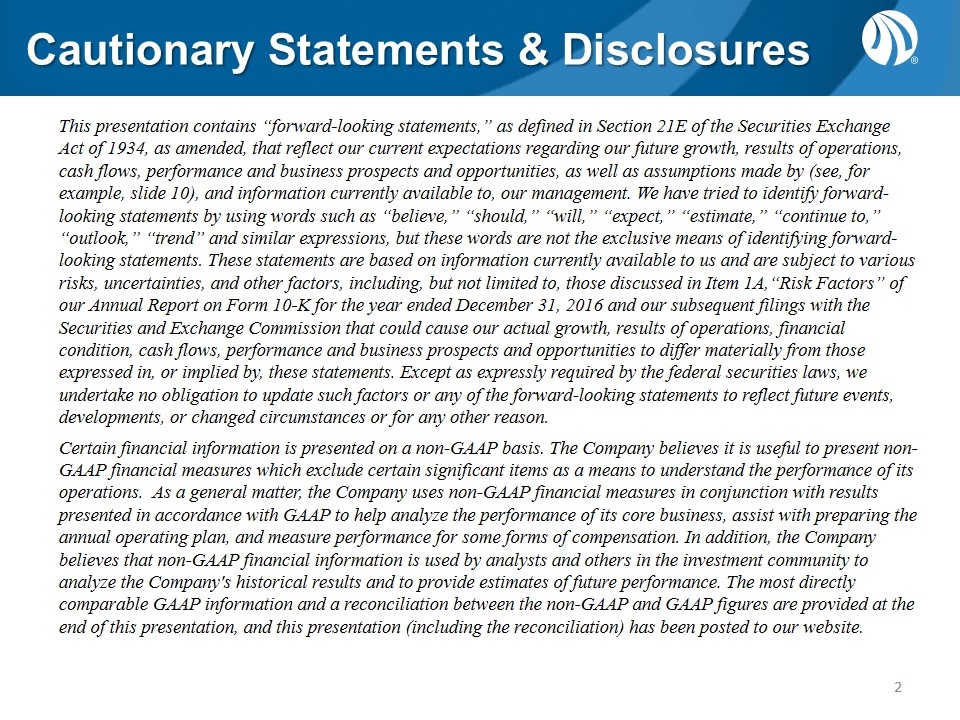
This presentation contains “forward-looking statements,” as defined in Section 21E of the Securities Exchange Act of 1934, as amended, that reflect our current expectations regarding our future growth, results of operations, cash flows, performance and business prospects and opportunities, as well as assumptions made by (see, for example, slide 10), and information currently available to, our management. We have tried to identify forward-looking statements by using words such as “believe,” “should,” “will,” “expect,” “estimate,” “continue to,” “outlook,” “trend” and similar expressions, but these words are not the exclusive means of identifying forward-looking statements. These statements are based on information currently available to us and are subject to various risks, uncertainties, and other factors, including, but not limited to, those discussed in Item 1A,“Risk Factors” of our Annual Report on Form 10-K for the year ended December 31, 2016 and our subsequent filings with the Securities and Exchange Commission that could cause our actual growth, results of operations, financial condition, cash flows, performance and business prospects and opportunities to differ materially from those expressed in, or implied by, these statements. Except as expressly required by the federal securities laws, we undertake no obligation to update such factors or any of the forward-looking statements to reflect future events, developments, or changed circumstances or for any other reason. Certain financial information is presented on a non-GAAP basis. The Company believes it is useful to present non-GAAP financial measures which exclude certain significant items as a means to understand the performance of its operations. As a general matter, the Company uses non-GAAP financial measures in conjunction with results presented in accordance with GAAP to help analyze the performance of its core business, assist with preparing the annual operating plan, and measure performance for some forms of compensation. In addition, the Company believes that non-GAAP financial information is used by analysts and others in the investment community to analyze the Company's historical results and to provide estimates of future performance. The most directly comparable GAAP information and a reconciliation between the non-GAAP and GAAP figures are provided at the end of this presentation, and this presentation (including the reconciliation) has been posted to our website. Cautionary Statements & Disclosures
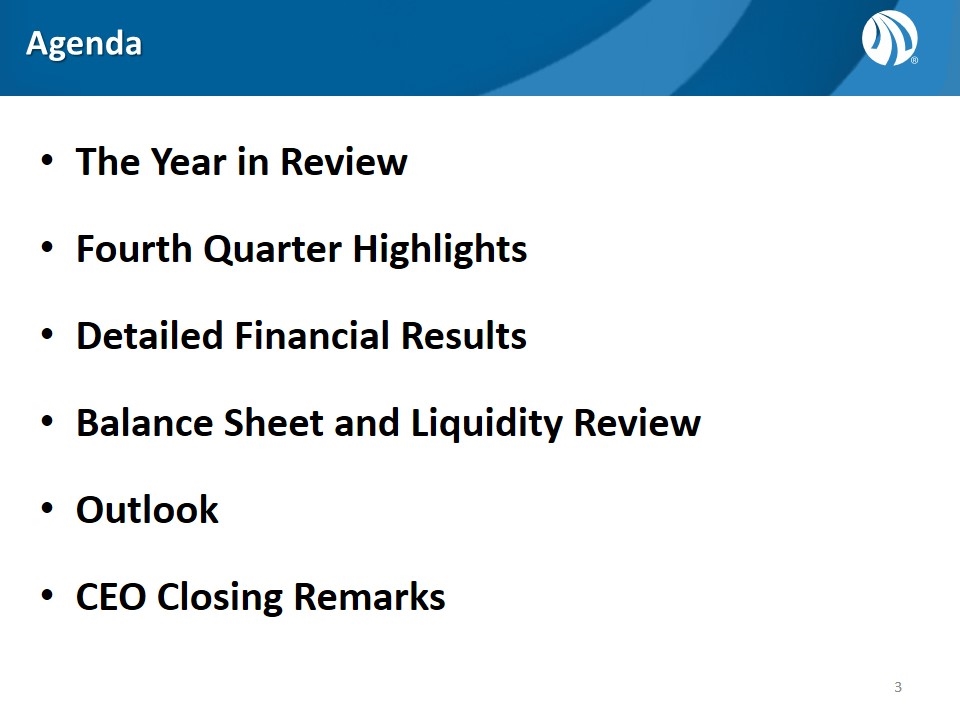
Agenda The Year in Review Fourth Quarter Highlights Detailed Financial Results Balance Sheet and Liquidity Review Outlook CEO Closing Remarks
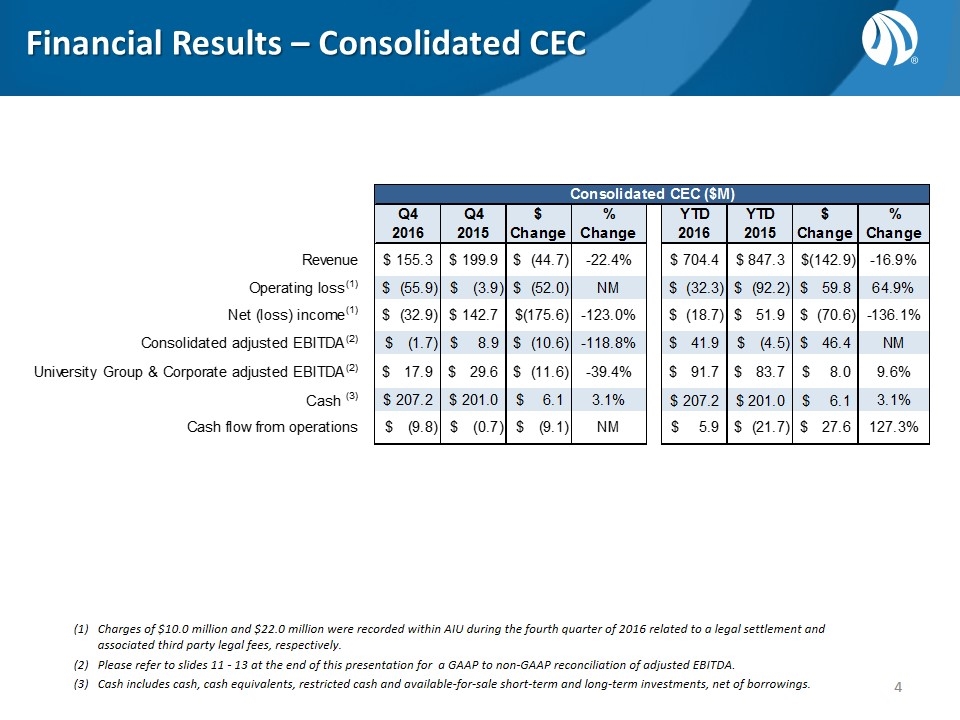
Financial Results – Consolidated CEC Charges of $10.0 million and $22.0 million were recorded within AIU during the fourth quarter of 2016 related to a legal settlement and associated third party legal fees, respectively. Please refer to slides 11 - 13 at the end of this presentation for a GAAP to non-GAAP reconciliation of adjusted EBITDA. Cash includes cash, cash equivalents, restricted cash and available-for-sale short-term and long-term investments, net of borrowings. Q4 Financial Results - Consolidated CEC Consolidated CEC ($M) Q42016 Q42015 $Change %Change YTD2016 YTD2015 $Change %Change Revenue $155.30000000000001 $199.9 $-44.7 -0.224 $704.4 $847.3 $-,142.9 -0.16900000000000001 Operating loss(1) $-55.9 $-3.9 $-52 NM $-32.299999999999997 $-92.2 $59.8 0.64900000000000002 Net (loss) income(1) $-32.9 $142.69999999999999 $-,175.6 -1.23 $-18.7 $51.9 $-70.599999999999994 -1.361 Consolidated adjusted EBITDA(2) $-1.7 $8.9 $-10.6 -1.1879999999999999 $41.9 $-4.5 $46.4 NM University Group & Corporate adjusted EBITDA(2) $17.899999999999999 $29.6 $-11.6 -0.39400000000000002 $91.7 $83.7 $8 9.6% Cash (3) $207.2 $201 $6.1 3.1% $207.2 $201 $6.1 3.1% Cash flow from operations $-9.8000000000000007 $-0.7 $-9.1 NM $5.9 $-21.7 $27.6 1.2729999999999999 *Consolidated CEC excludes Discontinued Operations
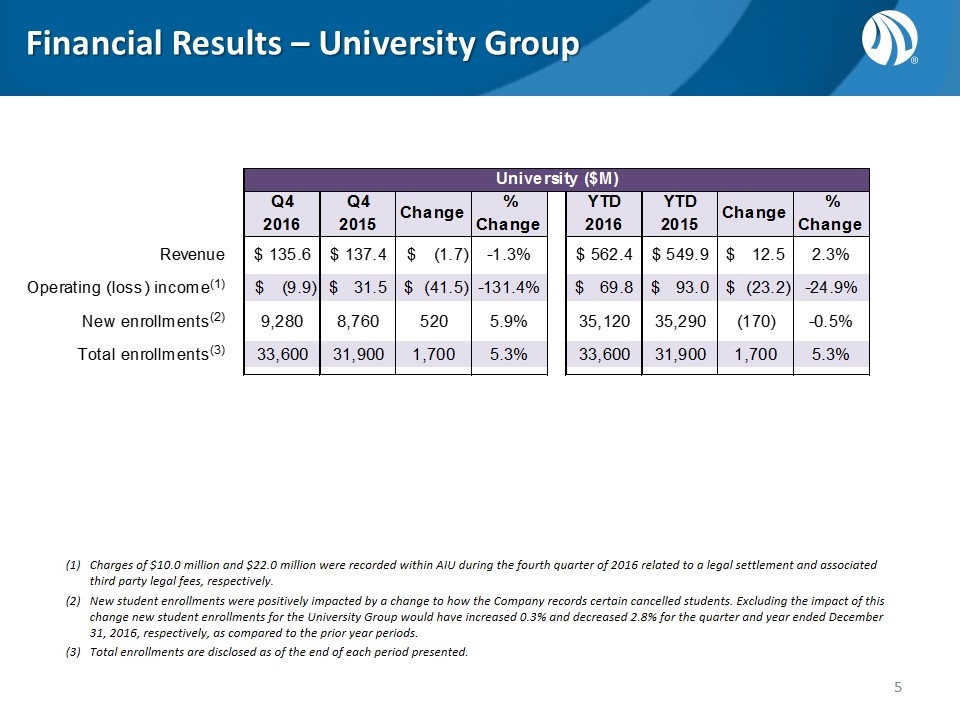
Financial Results – University Group Charges of $10.0 million and $22.0 million were recorded within AIU during the fourth quarter of 2016 related to a legal settlement and associated third party legal fees, respectively. New student enrollments were positively impacted by a change to how the Company records certain cancelled students. Excluding the impact of this change new student enrollments for the University Group would have increased 0.3% and decreased 2.8% for the quarter and year ended December 31, 2016, respectively, as compared to the prior year periods. Total enrollments are disclosed as of the end of each period presented. Q4 Financial Results - University University ($M) Q42016 Q42015 Change %Change YTD2016 YTD2015 Change %Change Revenue $135.6 $137.4 $-1.7 -1.3% $562.4 $549.9 $12.5 2.3% Operating (loss) income(1) $-9.9 $31.5 $-41.5 -1.3140000000000001 $69.8 $93 $-23.2 -0.249 New enrollments(2) 9,280 8,760 520 5.9% 35,120 35,290 -,170 -0.5% Total enrollments(3) 33,600 31,900 1,700 5.3% 33,600 31,900 1,700 5.3%

Financial Results - Culinary Arts & Transitional PHASE DOWN OF CAMPUSES IN TEACH-OUT Total enrollments are disclosed as of the end of each period presented. Teach-out dates are estimated based on current student enrollment and are subject to change. Campuses at Beginning of each Quarter(2) Q4 2015 Q4 2016 Q1 2017 Q1 2018 Q1 2019 44 34 30 6 0 - Q4 2016 includes 17 Transitional and 17 Culinary Arts campuses - All Culinary Arts campuses expected to teach-out by end of Q4 2017 Q4 Financial Results - Culinary & Transitional Culinary Arts ($M) Q42016 Q42015 Change %Change YTD2016 YTD2015 Change %Change Revenue $14.5 $42 $-27.6 -0.65600000000000003 $104.5 $170.2 $-65.7 -0.38600000000000001 Operating loss $-22.3 $-14.1 $-8.1999999999999993 -0.58399999999999996 $-20.6 $-57.6 $37 0.64200000000000002 Total enrollments (1) 2,300 7,800 -5,500 -0.70499999999999996 2,300 7,800 -5,500 -0.70499999999999996 Transitional ($M) Q42016 Q42015 Change %Change YTD2016 YTD2015 Change %Change Revenue $5.2 $20.5 $-15.3 -0.747 $37.6 $127.1 $-89.5 -0.70399999999999996 Operating loss $-15.8 $-15.1 $-0.7 -4.7% $-56.5 $-,100.3 $43.9 0.437 Total enrollments (1) 700 3,500 -2,800 -0.8 700 3,500 -2,800 -0.8 *Consolidated Briarcliffe counted as a single institution
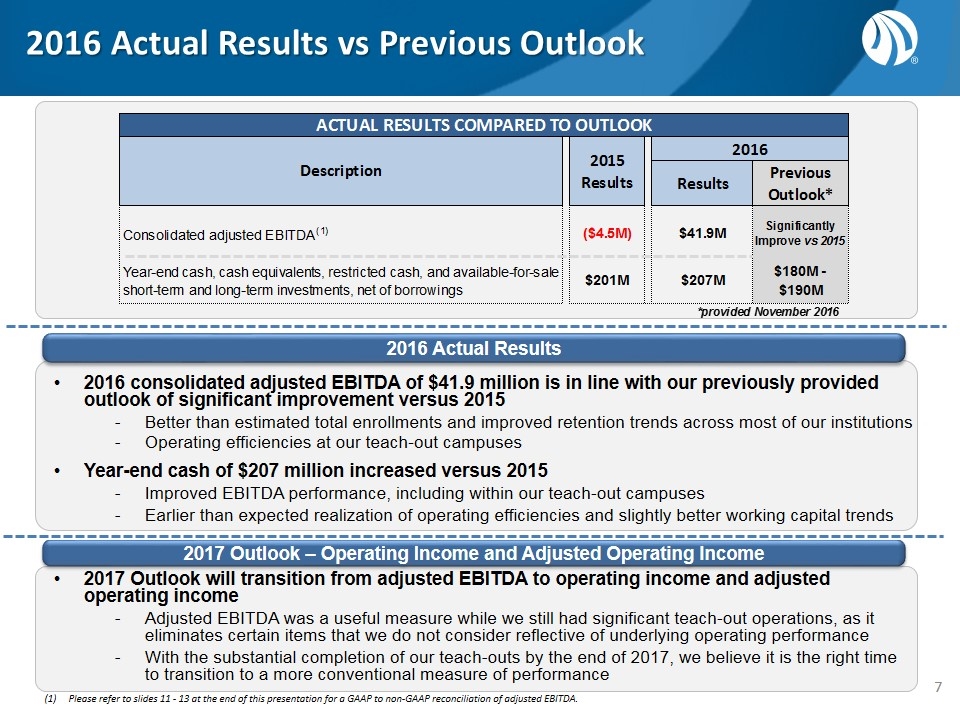
2017 Outlook – Operating Income and Adjusted Operating Income 2017 Outlook will transition from adjusted EBITDA to operating income and adjusted operating income Adjusted EBITDA was a useful measure while we still had significant teach-out operations, as it eliminates certain items that we do not consider reflective of underlying operating performance With the substantial completion of our teach-outs by the end of 2017, we believe it is the right time to transition to a more conventional measure of performance 2016 Actual Results vs Previous Outlook 2016 consolidated adjusted EBITDA of $41.9 million is in line with our previously provided outlook of significant improvement versus 2015 Better than estimated total enrollments and improved retention trends across most of our institutions Operating efficiencies at our teach-out campuses Year-end cash of $207 million increased versus 2015 Improved EBITDA performance, including within our teach-out campuses Earlier than expected realization of operating efficiencies and slightly better working capital trends 2016 Actual Results Please refer to slides 11 - 13 at the end of this presentation for a GAAP to non-GAAP reconciliation of adjusted EBITDA. ACTUAL RESULTS COMPARED TO OUTLOOK Description 2015Results 2016 Results Previous Outlook* Consolidated adjusted EBITDA(1) $-4,520,116.2489999998 $41,907,915.820009522 SignificantlyImprove vs 2015 Year-end cash, cash equivalents, restricted cash, and available-for-sale short-term and long-term investments, net of borrowings $201M $207M $180M -$190M *provided November 2016
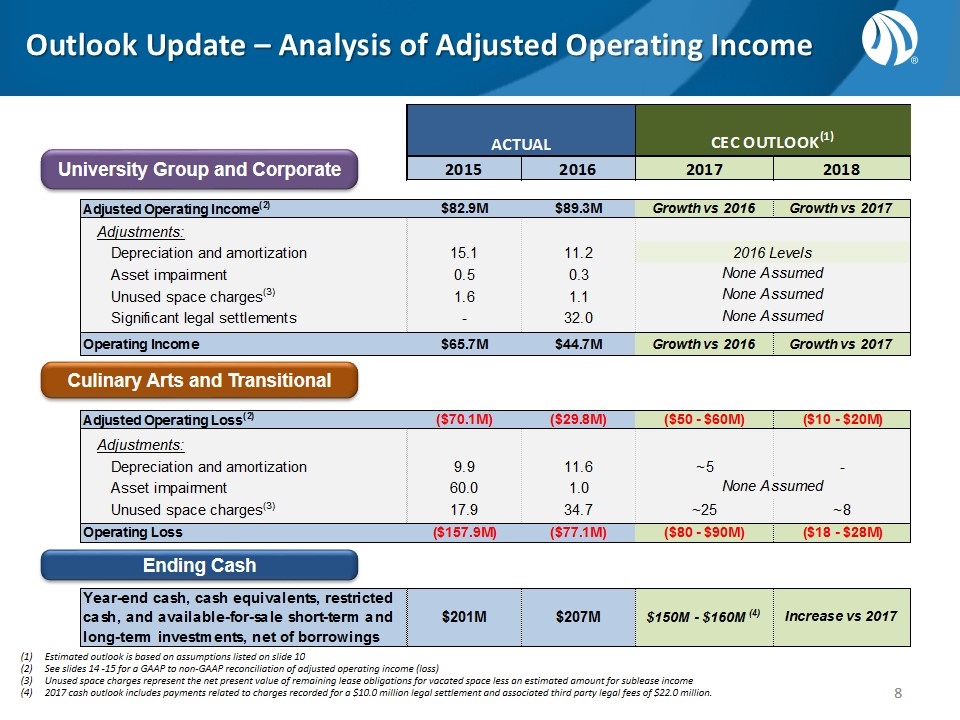
Outlook Update – Analysis of Adjusted Operating Income Estimated outlook is based on assumptions listed on slide 10 See slides 14 -15 for a GAAP to non-GAAP reconciliation of adjusted operating income (loss) Unused space charges represent the net present value of remaining lease obligations for vacated space less an estimated amount for sublease income 2017 cash outlook includes payments related to charges recorded for a $10.0 million legal settlement and associated third party legal fees of $22.0 million. University Group and Corporate Culinary Arts and Transitional Ending Cash ACTUAL CEC OUTLOOK(1) 2015 2016 2017 2018 UniversityCorporate Adjusted Operating Income(2) $82,900,000 $89,300,000 Growth vs 2016 Growth vs 2017 Adjustments: 44.7 Depreciation and amortization 15.1 11,164,501.84 2016 Levels 11.2 Asset impairment 0.5 ,257,025.98 None Assumed 0.3 Unused space charges(3) 1.6 1,133,634.28 None Assumed 1.1000000000000001 Significant legal settlements - 32,000,000 None Assumed 32 Operating Income $65,700,000 $44,700,000 Growth vs 2016 Growth vs 2017 89.300000000000011 TransCulinary Adjusted Operating Loss(2) $,-70,100,000 $,-29,800,000 ($50 - $60M) ($10 - $20M) -157.9 -77.099999999999994 Adjustments: 9.8000000000000007 11.6 Depreciation and amortization 9.9 11.6 ~5 0 60 0.9 Asset impairment 60 1 None Assumed 17.899999999999999 34.700000000000003 Unused space charges(3) 17.899999999999999 34.700000000000003 ~25 ~8 -70.199999999999989 -29.899999999999991 Operating Loss $-,157,900,000 $,-77,100,000 ($80 - $90M) ($18 - $28M) Year-end cash, cash equivalents, restricted cash, and available-for-sale short-term and long-term investments, net of borrowings $201M $207M $150M - $160M(4) Increase vs 2017
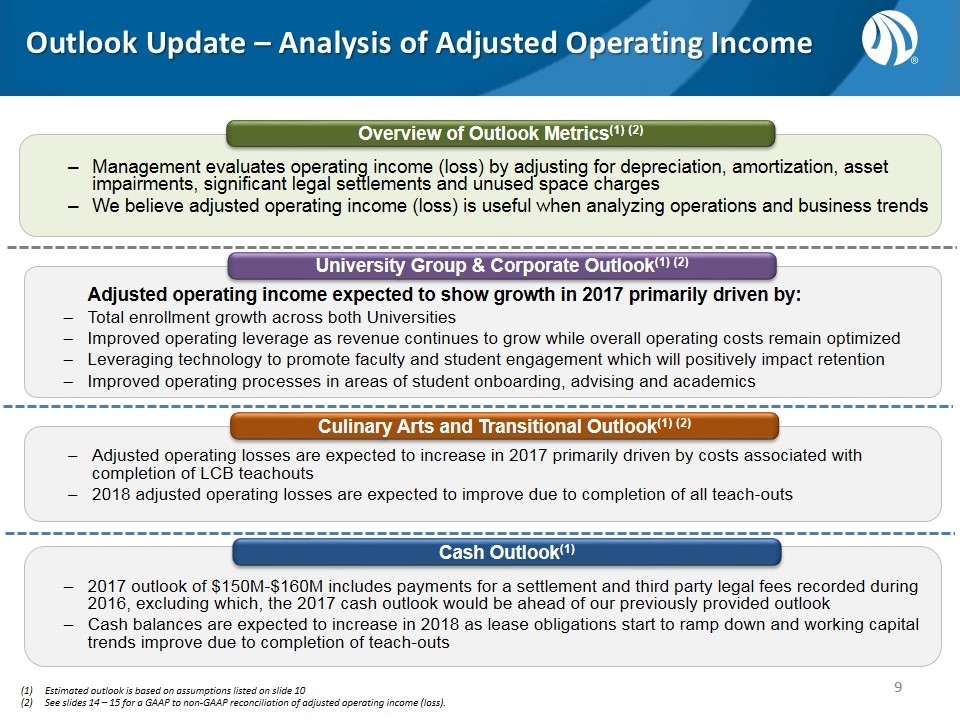
2017 outlook of $150M-$160M includes payments for a settlement and third party legal fees recorded during 2016, excluding which, the 2017 cash outlook would be ahead of our previously provided outlook Cash balances are expected to increase in 2018 as lease obligations start to ramp down and working capital trends improve due to completion of teach-outs Outlook Update – Analysis of Adjusted Operating Income Estimated outlook is based on assumptions listed on slide 10 See slides 14 – 15 for a GAAP to non-GAAP reconciliation of adjusted operating income (loss). Adjusted operating income expected to show growth in 2017 primarily driven by: Total enrollment growth across both Universities Improved operating leverage as revenue continues to grow while overall operating costs remain optimized Leveraging technology to promote faculty and student engagement which will positively impact retention Improved operating processes in areas of student onboarding, advising and academics Adjusted operating losses are expected to increase in 2017 primarily driven by costs associated with completion of LCB teachouts 2018 adjusted operating losses are expected to improve due to completion of all teach-outs University Group & Corporate Outlook(1) (2) Culinary Arts and Transitional Outlook(1) (2) Management evaluates operating income (loss) by adjusting for depreciation, amortization, asset impairments, significant legal settlements and unused space charges We believe adjusted operating income (loss) is useful when analyzing operations and business trends Overview of Outlook Metrics(1) (2) Cash Outlook(1)
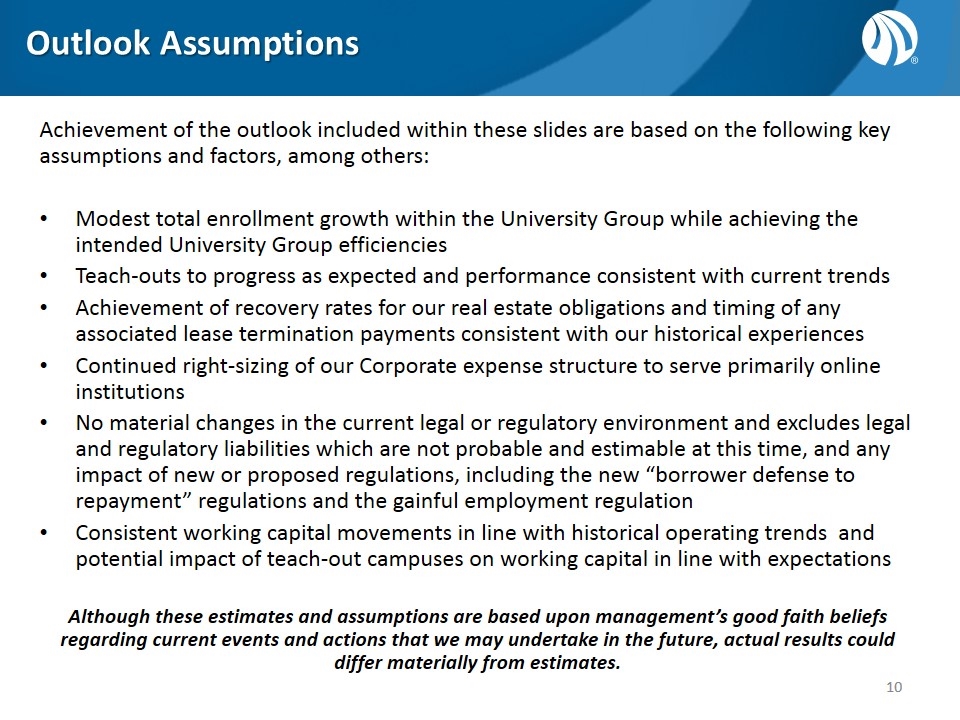
Outlook Assumptions Achievement of the outlook included within these slides are based on the following key assumptions and factors, among others: Modest total enrollment growth within the University Group while achieving the intended University Group efficiencies Teach-outs to progress as expected and performance consistent with current trends Achievement of recovery rates for our real estate obligations and timing of any associated lease termination payments consistent with our historical experiences Continued right-sizing of our Corporate expense structure to serve primarily online institutions No material changes in the current legal or regulatory environment and excludes legal and regulatory liabilities which are not probable and estimable at this time, and any impact of new or proposed regulations, including the new “borrower defense to repayment” regulations and the gainful employment regulation Consistent working capital movements in line with historical operating trends and potential impact of teach-out campuses on working capital in line with expectations Although these estimates and assumptions are based upon management’s good faith beliefs regarding current events and actions that we may undertake in the future, actual results could differ materially from estimates.
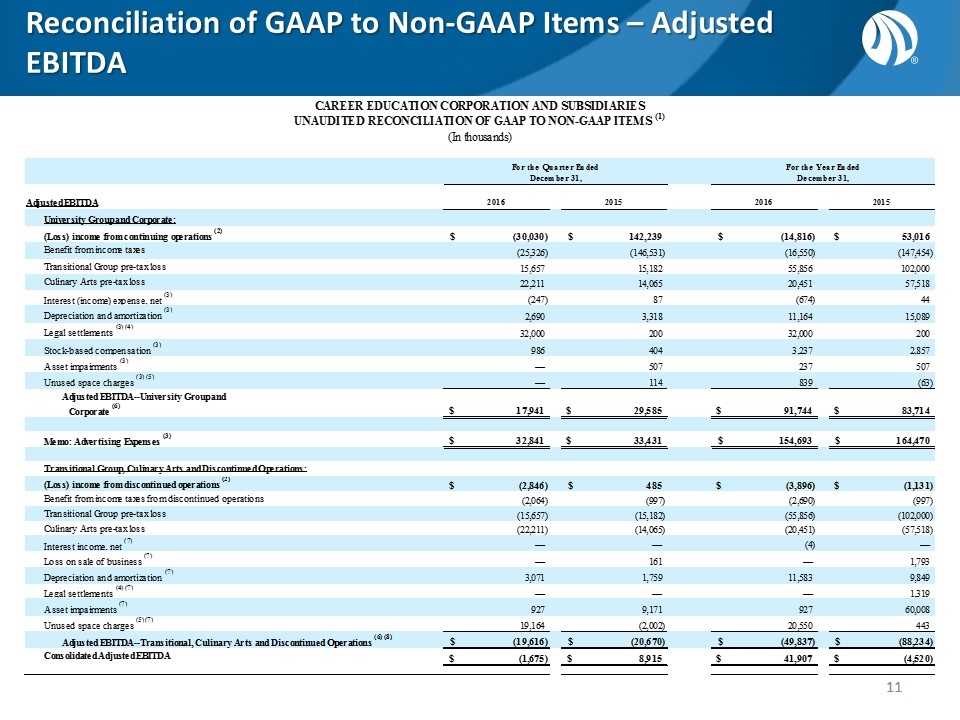
Reconciliation of GAAP to Non-GAAP Items – Adjusted EBITDA CAREER EDUCATION CORPORATION AND SUBSIDIARIES UNAUDITED RECONCILIATION OF GAAP TO NON-GAAP ITEMS (1) (In thousands) For the Quarter Ended December 31, For the Year Ended December 31, Adjusted EBITDA 2016 2015 2016 2015 University Group and Corporate: (Loss) income from continuing operations (2) $,-30,030 $,142,239 $,-14,816 $53,016 Benefit from income taxes ,-25,326 -,146,531 ,-16,550 -,147,454 Transitional Group pre-tax loss 15,657 15,182 55,856 ,102,000 Culinary Arts pre-tax loss 22,211 14,065 20,451 57,518 Interest (income) expense, net (3) -,247 87 -,674 44 Depreciation and amortization (3) 2,690 3,318 11,164 15,089 Legal settlements (3) (4) 32,000 200 32,000 200 Stock-based compensation (3) 986 404 3,237 2,857 Asset impairments (3) 0 507 237 507 Unused space charges (3) (5) 0 114 839 -63 Adjusted EBITDA--University Group and Corporate (6) $17,941 $29,585 $91,744 $83,714 Memo: Advertising Expenses (3) $32,841 $33,431 $,154,693 $,164,470 Transitional Group, Culinary Arts and Discontinued Operations: (Loss) income from discontinued operations (2) $-2,846 $485 $-3,896 $-1,131 Benefit from income taxes from discontinued operations -2,064 -,997 -2,690 -,997 Transitional Group pre-tax loss ,-15,657 ,-15,182 ,-55,856 -,102,000 Culinary Arts pre-tax loss ,-22,211 ,-14,065 ,-20,451 ,-57,518 Interest income, net (7) 0 0 -4 0 Loss on sale of business (7) 0 161 0 1,793 Depreciation and amortization (7) 3,071 1,759 11,583 9,849 Legal settlements (4) (7) 0 0 0 1,319 Asset impairments (7) 927 9,171 927 60,008 Unused space charges (5) (7) 19,164 -2,002 20,550 443 Adjusted EBITDA--Transitional, Culinary Arts and Discontinued Operations (6) (8) $,-19,616 $,-20,670 $,-49,837 $,-88,234 Consolidated Adjusted EBITDA $-1,675 $8,915 $41,907 $-4,520
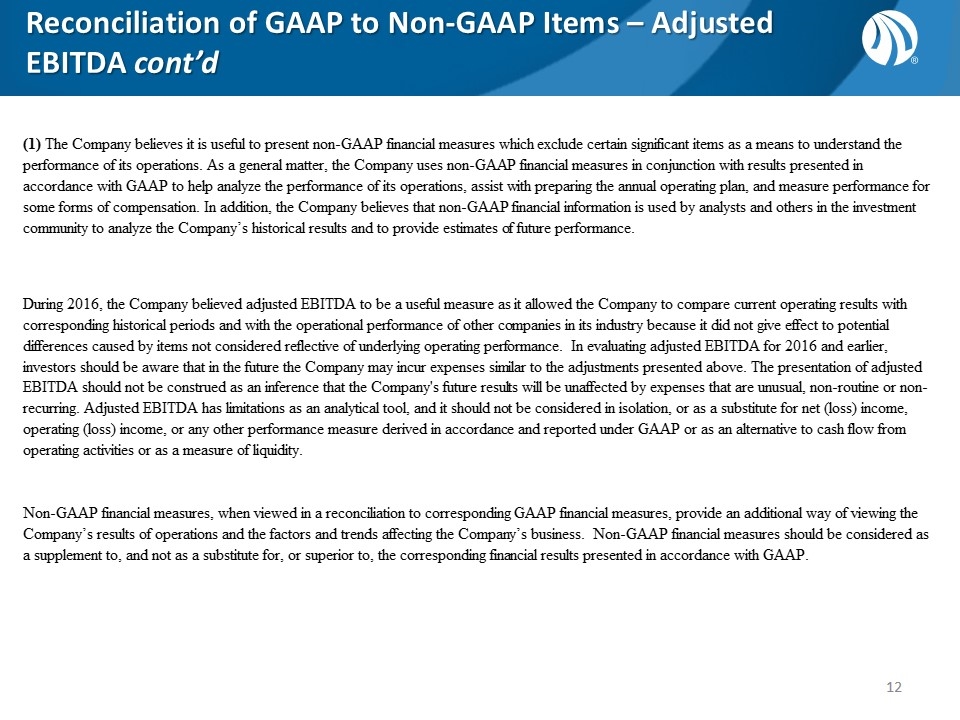
Reconciliation of GAAP to Non-GAAP Items – Adjusted EBITDA cont’d (1) The Company believes it is useful to present non-GAAP financial measures which exclude certain significant items as a means to understand the performance of its operations. As a general matter, the Company uses non-GAAP financial measures in conjunction with results presented in accordance with GAAP to help analyze the performance of its operations, assist with preparing the annual operating plan, and measure performance for some forms of compensation. In addition, the Company believes that non-GAAP financial information is used by analysts and others in the investment community to analyze the Company’s historical results and to provide estimates of future performance. During 2016, the Company believed adjusted EBITDA to be a useful measure as it allowed the Company to compare current operating results with corresponding historical periods and with the operational performance of other companies in its industry because it did not give effect to potential differences caused by items not considered reflective of underlying operating performance. In evaluating adjusted EBITDA for 2016 and earlier, investors should be aware that in the future the Company may incur expenses similar to the adjustments presented above. The presentation of adjusted EBITDA should not be construed as an inference that the Company's future results will be unaffected by expenses that are unusual, non-routine or non-recurring. Adjusted EBITDA has limitations as an analytical tool, and it should not be considered in isolation, or as a substitute for net (loss) income, operating (loss) income, or any other performance measure derived in accordance and reported under GAAP or as an alternative to cash flow from operating activities or as a measure of liquidity. Non-GAAP financial measures, when viewed in a reconciliation to corresponding GAAP financial measures, provide an additional way of viewing the Company’s results of operations and the factors and trends affecting the Company’s business. Non-GAAP financial measures should be considered as a supplement to, and not as a substitute for, or superior to, the corresponding financial results presented in accordance with GAAP.
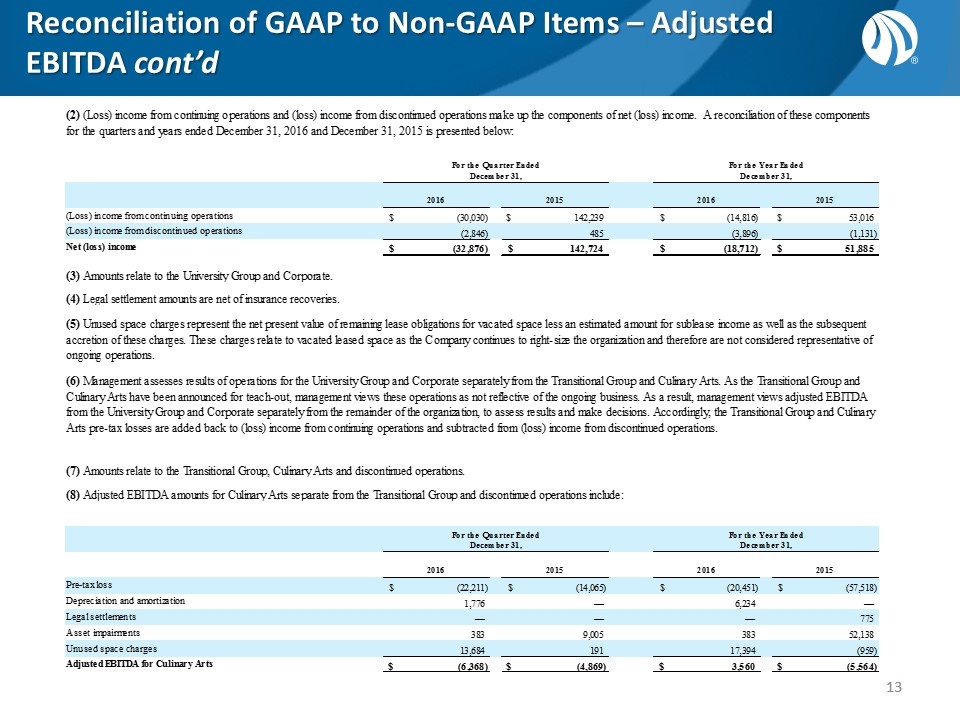
Reconciliation of GAAP to Non-GAAP Items – Adjusted EBITDA cont’d (2) (Loss) income from continuing operations and (loss) income from discontinued operations make up the components of net (loss) income. A reconciliation of these components for the quarters and years ended December 31, 2016 and December 31, 2015 is presented below: For the Quarter Ended December 31, For the Year Ended December 31, 2016 2015 2016 2015 (Loss) income from continuing operations $,-30,030 $,142,239 $,-14,816 $53,016 (Loss) income from discontinued operations -2,846 485 -3,896 -1,131 Net (loss) income $,-32,876 $,142,724 $,-18,712 $51,885 (3) Amounts relate to the University Group and Corporate. (4) Legal settlement amounts are net of insurance recoveries. (5) Unused space charges represent the net present value of remaining lease obligations for vacated space less an estimated amount for sublease income as well as the subsequent accretion of these charges. These charges relate to vacated leased space as the Company continues to right-size the organization and therefore are not considered representative of ongoing operations. (6) Management assesses results of operations for the University Group and Corporate separately from the Transitional Group and Culinary Arts. As the Transitional Group and Culinary Arts have been announced for teach-out, management views these operations as not reflective of the ongoing business. As a result, management views adjusted EBITDA from the University Group and Corporate separately from the remainder of the organization, to assess results and make decisions. Accordingly, the Transitional Group and Culinary Arts pre-tax losses are added back to (loss) income from continuing operations and subtracted from (loss) income from discontinued operations. (7) Amounts relate to the Transitional Group, Culinary Arts and discontinued operations. (8) Adjusted EBITDA amounts for Culinary Arts separate from the Transitional Group and discontinued operations include: For the Quarter Ended December 31, For the Year Ended December 31, 2016 2015 2016 2015 Pre-tax loss $,-22,211 $,-14,065 $,-20,451 $,-57,518 Depreciation and amortization 1,776 0 6,234 0 Legal settlements 0 0 0 775 Asset impairments 383 9,005 383 52,138 Unused space charges 13,684 191 17,394 -,959 Adjusted EBITDA for Culinary Arts $-6,368 $-4,869 $3,560 $-5,564

Reconciliation of GAAP to Non-GAAP Items – Adjusted Operating Income (Loss) CAREER EDUCATION CORPORATION AND SUBSIDIARIES UNAUDITED RECONCILIATION OF GAAP TO NON-GAAP ITEMS (1) (In thousands) ACTUAL RESULTS OUTLOOK For the Year Ended December 31, For the Year Ended December 31, Adjusted Operating Income (Loss) 2015 2016 2017 2018 University Group and Corporate: Operating income (2) (3) $65,749 $44,717 Growth vs 2016 Growth vs 2017 Depreciation and amortization (3) 15,089 11,164 2016 Levels Asset impairments (3) 507 237 None Assumed Unused space charges (3) (4) 1,556 1,134 None Assumed Significant legal settlements (3) 0 32,000 None Assumed Adjusted Operating Income --University Group and Corporate (5) $82,901 $89,252 Growth vs 2016 Growth vs 2017 Transitional Group and Culinary Arts: Operating loss (2) (6) $-,157,917 $,-77,061 $(80) -- $(90) million $(18) -- $(28) million Depreciation and amortization (6) 9,849 11,583 ~$5 million — Asset impairments (6) 60,008 927 None Assumed Unused space charges (4) (6) 17,940 34,719 ~$25 million ~$8 million Adjusted Operating Loss --Transitional and Culinary Arts (5) $,-70,120 $,-29,832 $(50) -- $(60) million $(10) -- $(20) million Tab 14 Tab 13 (1) The Company believes it is useful to present non-GAAP financial measures which exclude certain significant items as a means to understand the performance of its operations. As a general matter, the Company uses non-GAAP financial measures in conjunction with results presented in accordance with GAAP to help analyze the performance of its operations, assist with preparing the annual operating plan, and measure performance for some forms of compensation. In addition, the Company believes that non-GAAP financial information is used by analysts and others in the investment community to analyze the Company’s historical results and to provide estimates of future performance. The Company believes adjusted operating income (loss) allows it to analyze and assess its ongoing operations and compare current operating results with the operational performance of other companies in its industry because it does not give effect to potential differences caused by items it does not consider reflective of underlying operating performance, such as unused space charges and significant legal reserves. In evaluating adjusted operating income (loss), investors should be aware that in the future the Company may incur expenses similar to the adjustments presented above. The presentation of adjusted operating income (loss) should not be construed as an inference that the Company's future results will be unaffected by expenses that are unusual, non-routine or non-recurring. Adjusted operating income (loss) has limitations as an analytical tool, and it should not be considered in isolation, or as a substitute for net (loss) income, operating (loss) income, or any other performance measure derived in accordance and reported under GAAP or as an alternative to cash flow from operating activities or as a measure of liquidity. Non-GAAP financial measures, when viewed in a reconciliation to corresponding GAAP financial measures, provide an additional way of viewing the Company’s results of operations and the factors and trends affecting the Company’s business. Non-GAAP financial measures should be considered as a supplement to, and not as a substitute for, or superior to, the corresponding financial results presented in accordance with GAAP. (2) Operating income for University Group and Corporate and operating loss for the Transitional Group and Culinary Arts make up the components of operating (loss) income. A reconciliation of these components for the years ended December 31, 2016 and December 31, 2015 is presented below: For the Year Ended December 31, 2015 2016 Operating income for University Group and Corporate $65,749 $44,717 Operating loss for Culinary Arts and Transitional -,157,917 ,-77,061 Operating loss $,-92,168 $,-32,344 (3) Amounts relate to the University Group and Corporate. (4) Unused space charges represent the net present value of remaining lease obligations for vacated space less an estimated amount for sublease income. These charges relate to exiting leased space as the Company continues to right-size the organization and therefore are not considered representative of ongoing operations. (5) Management assesses results of operations for the University Group and Corporate separately from the Transitional Group and Culinary Arts. As the Transitional Group and Culinary Arts have been announced for teach-out, management views these operations as not reflective of the ongoing business. As a result, management views adjusted operating income from the University Group and Corporate separately from the remainder of the organization, to assess results and make decisions. (6) Amounts relate to the Transitional Group and Culinary Arts.

Reconciliation of GAAP to Non-GAAP Items – Adjusted Operating Income (Loss) cont’d CAREER EDUCATION CORPORATION AND SUBSIDIARIES UNAUDITED RECONCILIATION OF GAAP TO NON-GAAP ITEMS (1) (In thousands) ACTUAL RESULTS OUTLOOK For the Year Ended December 31, For the Year Ended December 31, Adjusted Operating Income (Loss) 2015 2016 2017 2018 University Group and Corporate: Operating income (2) (3) $65,749 $44,717 Growth vs 2016 Growth vs 2017 Depreciation and amortization (3) 15,089 11,164 2016 Levels Asset impairments (3) 507 237 None Assumed Unused space charges (3) (4) 1,556 1,134 None Assumed Significant legal reserves (3) 0 32,000 None Assumed Adjusted Operating Income --University Group and Corporate (5) $82,901 $89,252 Growth vs 2016 Growth vs 2017 Transitional Group and Culinary Arts: Operating loss (2) (6) $-,157,917 $,-77,061 $(75) -- $(85) million $(20) -- $(30) million Depreciation and amortization (6) 9,849 11,583 $4 -- $6 million — Asset impairments (6) 60,008 927 None Assumed Unused space charges (4) (6) 17,940 34,728 $18 -- $24 million $2 -- $6 million Adjusted Operating Loss --Transitional and Culinary Arts (5) $,-70,120 $,-29,823 $(45) -- $(63) million $(14) -- $(28) million Tab 14 Tab 13 (1) The Company believes it is useful to present non-GAAP financial measures which exclude certain significant items as a means to understand the performance of its operations. As a general matter, the Company uses non-GAAP financial measures in conjunction with results presented in accordance with GAAP to help analyze the performance of its operations, assist with preparing the annual operating plan, and measure performance for some forms of compensation. In addition, the Company believes that non-GAAP financial information is used by analysts and others in the investment community to analyze the Company’s historical results and to provide estimates of future performance. The Company believes adjusted operating income (loss) allows it to analyze and assess its ongoing operations and compare current operating results with the operational performance of other companies in its industry because it does not give effect to potential differences caused by items it does not consider reflective of underlying operating performance, such as unused space charges and significant legal reserves. In evaluating adjusted operating income (loss), investors should be aware that in the future the Company may incur expenses similar to the adjustments presented above. The presentation of adjusted operating income (loss) should not be construed as an inference that the Company's future results will be unaffected by expenses that are unusual, non-routine or non-recurring. Adjusted operating income (loss) has limitations as an analytical tool, and it should not be considered in isolation, or as a substitute for net (loss) income, operating (loss) income, or any other performance measure derived in accordance and reported under GAAP or as an alternative to cash flow from operating activities or as a measure of liquidity. Non-GAAP financial measures, when viewed in a reconciliation to corresponding GAAP financial measures, provide an additional way of viewing the Company’s results of operations and the factors and trends affecting the Company’s business. Non-GAAP financial measures should be considered as a supplement to, and not as a substitute for, or superior to, the corresponding financial results presented in accordance with GAAP. (2) Operating income for University Group and Corporate and operating loss for the Transitional Group and Culinary Arts make up the components of operating (loss) income. A reconciliation of these components for the years ended December 31, 2016 and December 31, 2015 is presented below: For the Year Ended December 31, 2015 2016 Operating income for University Group and Corporate $65,749 $44,717 Operating loss for Culinary Arts and Transitional -,157,917 ,-77,061 Operating loss $,-92,168 $,-32,344 (3) Amounts relate to the University Group and Corporate. (4) Unused space charges represent the net present value of remaining lease obligations for vacated space less an estimated amount for sublease income. These charges relate to exiting leased space as the Company continues to right-size the organization and therefore are not considered representative of ongoing operations. (5) Management assesses results of operations for the University Group and Corporate separately from the Transitional Group and Culinary Arts. As the Transitional Group and Culinary Arts have been announced for teach-out, management views these operations as not reflective of the ongoing business. As a result, management views adjusted operating income from the University Group and Corporate separately from the remainder of the organization, to assess results and make decisions. (6) Amounts relate to the Transitional Group and Culinary Arts.
